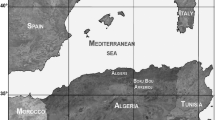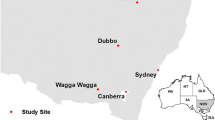Abstract
As a result of climate change, and in particular rainfall changes, agricultural production is likely to change across the globe. Until now most research has focused on areas which will become unsustainable for agricultural production. However, there are also regions where climate change might actually improve conditions for growth. In the western Pampas region of Argentina, average annual rainfall has increased by 100–200 mm over the last 70 years, mainly during summer. Wheat is grown during winter, primarily on stored soil water and the main factor limiting plant production in this area is rainfall. Using the well tested simulation model APSIM-NWheat, we studied whether recent climate change has potentially opened new opportunities for wheat cropping in Argentina. Simulation results indicated that the additional rainfall in the Pampas of Argentina has increased the achievable yield (defined as the yield limited by solar radiation, temperature, water and nitrogen supply) of wheat in the currently cropped region, but less than expected based on the large amount of additional rainfall. The higher achievable yield from additional rainfall could potentially allow an expansion of profitable wheat cropping into currently non-cropped areas, where the achievable wheat yield increased in average from 1 t/ha to currently 2 t/ha. However, the poor water-holding capacity of the sandy soils which dominate the region outside the current cropping area limits the systems ability to use most of the increased summer rainfall. Nevertheless, the current higher achievable yield indicates a suitability of the region for cropping, which will slightly decline or remain unchanged depending on summer rainfall storage, with current and future climate change, including projected changes in rainfall, temperature and atmospheric CO2 concentration. Factors other than just the achievable yield will eventually influence any future development of this region for cropping, including the high sensitivity of the sandy soils to erosion and nutrient leaching, current relatively high land prices, restrictions on clearing for cropping, the distance to the nearest port and current unsuitable cultivars withstanding the high frost risk.






Similar content being viewed by others
References
AAPRESID (2011) Asociación Argentina de Productores de Siembra Directa (Argentine No-till Farmers Association) www.aapresid.org.ar
Adema EO, Babinec FJ, Buschiazzo DE, Martín MJ, Peinemann N (2003) Erosión hídrica en suelos del caldenal. Publicación Técnica N°53. EEA Anguil, INTA, Argentina, ISSN 0325 2132
Anderson GC, Fillery IRP, Dunin FX, Dolling PJ, Asseng S (1998) Nitrogen and water flows under pastrue-wheat and lupin-wheat rotations in deep sands in Western Australia—2. Drainage and nitrate leaching. Aust J Agric Res 49:345–361
Anonymous (2003) PlanFarm Farm Business Survey 2003
Anonymous (2008) FAO food outlook, global market analsyis. http://www.fao.org/
Asseng S, Fillery IRP, Anderson GC, Dolling PJ, Dunin FX, Keating BA (1998a) Use of the APSIM wheat model to predict yield, drainage, and NO −13 leaching for deep sand. Aust J Agric Res 49:363–377
Asseng S, Keating BA, Fillery IRP, Gregory PJ, Bowden JW, Turner NC, Palta JA, Abrecht DG (1998b) Performance of the APSIM-Wheat model in Western Australia. Field Crops Res 57:163–179
Asseng S, van Keulen H, Stol W (2000) Performance and application of the APSIM Nwheat model in the Netherlands. Eur J Agron 12:37–54
Asseng S, Fillery IRP, Dunin FX, Keating BA, Meinke H (2001) Potential deep drainage under wheat crops in a mediterranean climate. I. Temporal and spatial variability. Aust J Agric Res 52:45–56
Asseng S, Bar-Tal A, Bowden JW, Keating B, van Herwaarden AF, Palta JA, Huth N, Probert ME (2002) Simulation of grain protein content with ASPIM-Nwheat. Eur J Agron 16:25–42
Asseng S, Jamieson PD, Kimball B, Pinter P, Sayre K, Bowden JW, Howden SM (2004) Simulated wheat growth affected by rising temperature, increased water deficit and elevated atmospheric CO2. Field Crops Res 85:85–102
Asseng S, Milroy SP, Poole ML (2008) Systems analysis of wheat production on low water-holding soils in a Mediterranean-type environment I. Yield potential and quality. Field Crop Res 105:97–106
Barsky O, Davila M (2008) La rebelión del campo. Ed. Sudamericana, Bs.As., Argentina. 346 p. ISBN: 950-07-2962-8
Buschiazzo DE, Zobeck TM, Abascal SA (2007) Wind erosion quantity and quality of an Entic Haplustoll of the semi-arid Pampas of Argentina. J Arid Environ 69:29–39
Challinor A, Wheeler T, Garforth C, Craufurd P, Kassam A (2007) Assessing the vulnerability of food crop systems in Africa to climate change. Clim Chang 83:381–399
Fernández Long ME, Barnatán IE, Spescha L, Hurtado R, Murphy G (2004) Caracterización de las heladas en la Región Pampeana y su variabilidad en los últimos 10 años. Rev Facultad de Agronomía 25(3):247–257
Fischer RA (1979) Growth and water limitation to dryland wheat yield in Australia: a physiological framework. J Aust Inst Agr Sci 45:83–94
French RJ, Schultz JE (1984) Water use efficiency of wheat in a mediterranean-type environment. I. The relation between yield, water use and climate. Aust J Agric Res 35:743–764
Giorgi F, Bi X (2005) Regional changes in surface climate interannual variability for the 21st century from ensembles of global model simulations. Geophys Res Lett 32
Grimm AM, Barros VR, Doyle ME (2000) Climate variability in Southern South America associated with. El Niño and La Niña events. J Clim 1:35–58
Hall AJ, Rebella CM, Ghersa CM, Culot JP (1992) Field-crop systems of the Pampas. In: Pearson CJ (ed) Field crop ecosystems. Ecosystems of the world. Elsevier, pp 413–450
INTA (1990) Atlas de suelos de la Republica Argentina. INTA (eds) Buenos Aires, Argentina, pp. 677
IPCC (2007) Climate Change 2007. Cambridge Press, New York
Keating BA, Meinke H, Probert ME, Huth NI, Hills I (2001) NWheat: Documentation and performance of a wheat module for APSIM. CSIRO. Tropical Agriculture Technical Memorandum. CSIRO Tropical Agriculture, Indooroopilly
Keating BA, Carberry PS, Hammer GL, Probert ME, Robertson MJ, Holzworth D, Huth NI, Hargreaves JNG, Meinke H, Hochman Z, Mclean G, Verburg K, Snow V, Dimes JP, Silburn M, Wang E, Brown S, Bristow KL, Asseng S, Chapman S, Mccown RL, Freebairn DM, Smith CJ (2003) An Overview of APSIM, a model designed for farming systems simulation. Eur J Agron 18:267–288
Kirkegaard JA, Lilley JM (2007) Root penetration rate—a benchmark to identify soil and plant limitations to rooting depth in wheat. Aust J Exp Agric 47:590–602
Ludwig F, Asseng S (2006) Climate change impacts on wheat production in a Mediterranean environment in Western Australia. Agric Syst 90:159–179
Ludwig F, Asseng S (2010) Adaptation of wheat systems to climate change through the introduction of plant traits related to early vigor and flowering time. Agric Syst 103:127–136
Ludwig F, Milroy S, Asseng S (2009) Impacts of recent climate change on wheat production systems in Western Australia. Clim Chang 92:495–517
Luo QY, Bellotti W, Williams M, Bryan B (2005) Potential impact of climate change on wheat yield in South Australia. Agr Forest Meteorol 132:273–285
Magrin GO, Travasso MI, Rodriguez GR (2005) Changes in climate and crop production during the 20th century in Argentina. Clim Chang 72:229–249
Magrin GC, Gay García D, Cruz Choque JC, Giménez AR, Moreno GJ, Nagy C, Villamizar A, Latin America (2007) Contribution of working group II to the fourth assessment report of the intergovernmental panel on climate change. In: Parry ML, Canziani OF, Palutikof JP, van der Linden PJ, Hanson CE (eds) Climate change (2007) impacts, adaptation and vulnerability. Cambridge University Press, Cambridge
Magrin GO, Travasso MI, Rodríguez GR, Solman S, Nuñez M (2009) Global warming and wheat production in Argentina. Int J Global Warming 1:214–226
Mall RK, Singh R, Gupta A, Srinivasan G, Rathore LS (2007) Impact of climate change on Indian agriculture: a review. Clim Chang 78:445–478
Martellotto E, Salinas A, Salas H, Lovera E, Giubergia J, Capuccino V, Lopez C, Signorile O, Lingua S, Alvarez C, Cantarero M, Viotti G (2005) TRIGO: un aporte a la sostenibilidad de los sistemas productivos. Evaluación en riego y secano de cultivares y estrategias de manejo en 8 localidades de la Provincia de Córdoba -Campaña 2004. Available at: http://www.riego.org.ar
Mendelsohn R (2007) What causes crop failure? Clim Chang 81(1):61–70
Olesen JE, Carter TR, Diaz-Ambrona CH, Fronzek S, Heidmann T, Hickler T, Holt T, Quemada M, Ruiz-Ramos M, Rubaek GH, Sau F, Smith B, Sykes MT (2007) Uncertainties in projected impacts of climate change on European agriculture and terrestrial ecosystems based on scenarios from regional climate models. Clim Chang 81:123–143
Ormeño O, Quiroga A (2001) Aspectos del manejo de la cobertura en relación con la conservación de los suelos y el agua. Boletín Técnico Nº 72 INTA, EEA Anguil, ISSN 0325-2167
Probert ME, Keating BA, Thompson JP, Parton WJ (1995) Modelling water, nitrogen, and crop yield for a long-term fallow management experiment. Aust J Exp Agr 35:941–950
Probert ME, Dimes JP, Keating BA, Dalal RC, Strong WM (1997) APSIM’s water and nitrogen modules and simulation of the dynamics of water and nitrogen in fallow systems. Agric Syst 56:1–28
Probert ME, Carberry PS, McCown RL, Turpin JE (1998) Simulation of legume-cereal systems using APSIM. Aust J Agric Res 49:317–327
Quiroga AR, Funaro DO, Fernández R, Noellemeyer EJ (2005) Soil and management factors conditioning fallow efficiency in the Pampas Region (in Spanish). C Suelo 23(1):79–86
Ramos MC, Martinez-Casasnovas JA (2006) Trends in precipitation concentration and extremes in the Mediterranean Penedes-Anoia region, NE Spain. Clim Chang 74:457–474
Raupach MR, Marland G, Ciais P, Le Quere C, Canadell JG, Klepper G, Field CB (2007) Global and regional drivers of accelerating CO2 emissions. PNAS 104:10288–10293
Re M, Barros VR (2009) Extreme rainfalls in SE South America. Clim Chang 96:119–136
Reyenga PJ, Howden SM, Meinke H, McKeon GM (1999) Modelling global change impacts on wheat cropping in south-east Queensland, Australia. Environ Modell Softw 14:297–306
Viglizzo EF, Roberto ZE, Filippin MC, Pordomingo AJ (1995) Climate variability and agroecological change in the central Pampas of Argentina. Agricult Ecosys Environ 55:7–16
Wessolek G, Asseng S (2006) Trade-off between wheat yield and drainage under current and climate change conditions in northeast Germany. Eur J Agron 24:333–342
Wong MTF, Asseng S (2006) Determining the causes of spatial and temporal variability of wheat yields at sub-field scale using a new method of upscaling a crop model. Plant Soil 283:203–215
Yang X, Lin E, Ma S, Ju H, Guo L, Xong W, Li Y, Xu Y (2007) Adaptation of agriculture to warming in Northeast China. Clim Chang 84:45–48
Acknowledgments
We would like to thank Nirav Khimashia and APSRU for technical support and Anthony van Herwaarden and Andrew James and two anonymous reviewers for constructive comments on an earlier draft. This study received financial support from the Department of Agriculture and Food Western Australia.
Author information
Authors and Affiliations
Corresponding author
Rights and permissions
About this article
Cite this article
Asseng, S., Travasso, M.I., Ludwig, F. et al. Has climate change opened new opportunities for wheat cropping in Argentina?. Climatic Change 117, 181–196 (2013). https://doi.org/10.1007/s10584-012-0553-y
Received:
Accepted:
Published:
Issue Date:
DOI: https://doi.org/10.1007/s10584-012-0553-y




